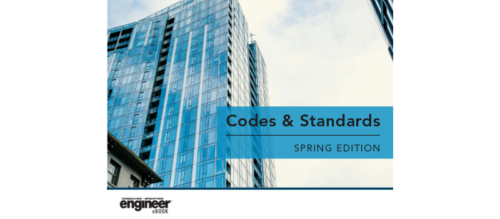Boiler Check
Consulting-Specifying Engineer: What are some factors to consider when specifying boilers or water heaters? SMARR: In recent years, first cost has usually been the most important factor. This being the case, modular boilers—often firetube type—are attractive. The building heat load is divided by the number of standard modular boilers required to handle the load, and sometimes a spa...
Consulting-Specifying Engineer: What are some factors to consider when specifying boilers or water heaters?
SMARR : In recent years, first cost has usually been the most important factor. This being the case, modular boilers—often firetube type—are attractive. The building heat load is divided by the number of standard modular boilers required to handle the load, and sometimes a spare N+1 is added to the equation.
WILSON : We’ve found that, in recent years, steam boilers are generally used in the replacement market. According to industry statistics, low-pressure steam represents about 20% of firetube sales, 15% of watertube sales and 30% of cast-iron sales. About 50% of firetube boilers and only 13% of watertube boilers are used in high-pressure steam applications.
For new construction, hydronic heating systems—using hot water—are typical. Also, many older steam systems are converted to hot water when their original steam boilers are in need of replacement. Retrofits and replacements often involve limited access to existing equipment rooms. In these situations, rigging and demolition expenses may tip the scales toward either a compact boiler design capable of moving through a doorway or corridor, or a knocked-down product configuration.
KARIDIS : There are some other factors involved, including load size, owner/operator goals and preferences, mechanical space availability, cost, local licensing regulations and utility rates.
WILSON : Also, fuel certainly plays a part in boiler selection. While gas-only boilers are available in all types, the choice of oil, or a combination gas/oil, eliminates some boiler types. Copper boilers are not available for oil firing, and heavy oil is only available in firetube models.
Venting is another variable. Boilers are available for atmospheric chimney venting, forced draft venting and sealed combustion, all of which lend themselves to different boiler types.
CSE: What are the size ranges for the various boiler types?
WILSON : Today’s copper boilers are limited in size from 2.5 to 3.0 mm BTU. Standard commercial cast-iron products approach 5 mm BTU in either packaged or knocked-down versions, while both watertube and firetube are available in sizes up to the 800- to 1,200-hp range. Modular cast-iron boilers are typically 400 MBh or smaller in size and are used in multiples to reach a larger heating requirement.
Design water pressure (DWP) must also be taken into account. Cast-iron designs are usually limited to a DWP of 70-80 psig. However, watertube and firetube boilers have optional higher DWP limits in the 125- to 250-psig range. Copper has a high standard DWP of 160 psig.
CSE: Now that we’ve discussed the different types and sizes of boilers, how does one decide between a steam or hot-water system?
KARIDIS : Specifying steam often depends on either a substantial process need—such as sterilizers and autoclaves—or an existing campus plant with available service.
SMARR : If there’s a need for process steam, it’s usually more economical to generate steam and use it for both heating and process. The steam can be converted to hot water for heating via heat exchangers. However, if there’s not a need for process steam, it’s usually more economical to use a hot-water boiler.
UTZINGER : Another issue to consider is that, depending on the temperature required for a particular process, applications requiring more than 50 hp should use a boiler. But the real determining factors are optimal temperature for a particular process and how cost-effective it is to deliver heat to the process. For example, it’s difficult for a system to deliver steam at 275
KARIDIS : Some other advantages of steam are that it can be supplied without pumps over a significant distance or height, and it permits local work without draining, filling and venting.
BOGGS : It’s also important to note that knowledgeable steam system operators are becoming rare. At the same time, steam systems usually have a higher maintenance cost. Also, process boilers for steam humidification or specific process demands affect the product selection just as much as first-cost and life-cycle cost issues.
For deciding which type of system to use, the considerations include boiler feedwater treatment, frost protection, pressure-reducing stations with converters to hydronic, distribution requirements and condensate return issues. But for typical building heating, hot-water systems have proven more cost-effective.
KARIDIS : Also, unlike steam, hot water is returned without traps or condensate pumps and is forgiving of pipe-routing changes. In fact, many owners are considering closed-loop hydronic systems, because they’re simpler to operate.
CSE: What are some of the other important new developments in boiler technology?
SMARR : One new technology allows condensing of flue gas in the boiler to raise the efficiency with stainless steel or other corrosion-resistant materials being used. For hot water boilers, reset of water temperature is being used to follow the lead for increased efficiency, and to operate with the lowest water temperature that meets the needs.
KARIDIS : Condensing boilers, when coupled with a low water-inlet temperature, as in a water heater, can extract enough latent heat from the flue stream to push boiler efficiency percentages into the upper 90s. Direct-contact heaters, touting even higher efficiencies, may find use on once-through process water systems where contact with products of combustion is not a water chemistry concern.
BOGGS : There have also been important developments in control technology. Stand-alone control systems that are independent, but which can still communicate with building automation systems, are being incorporated, as are multi-fuel (oil/gas) systems with better controls.
WILSON : I’d also say that the area of greatest interest and activity is controls systems. The growth of radiant floor heating and the expanded use of indirect water heaters—in conjunction with boilers and the availability of more sophisticated, intelligent controls—are allowing boiler manufacturers to design and deliver products that offer more value to the end user.
In addition, advancements in casting and burner designs have resulted in continually improving performance—even though fundamental designs of cast-iron, watertube and firetube boilers have changed little in the last 20 years.
In the case of cast-iron boilers, improved heat transfer surfaces are resulting from manufacturers being able to accurately model and measure casting performance. Technologies such as thermal imaging and computational fluid dynamics enable designers to optimize casting configurations for maximum heating performance and long-term reliability.
In the area of burner technology, low-emissions power burners are rapidly making their way into more and more watertube and firetube boiler/burner packaged systems. Pre-mix gas burners are being employed in newer, smaller boiler designs and in condensing designs, which typically use a secondary heat exchanger. And ceramic gas burners are being used in some smaller models with resulting higher efficiencies and lower NOx levels.
CSE: What recent code changes have affected heating system requirements in buildings?
WILSON : ASME CSD-1-2002 “Controls and Safety Devices for Automatically Fired Boilers” is being adopted by more state codes and is used as a minimum for boiler installations.
UTZINGER : The most recent code changes are air pollution laws that dictate NOx emission levels. So far, four states have instituted regulations that affect boilers. However, even though the code says that all states east of the Mississippi need to consider NOx levels, so far these regulations have only been applied in areas such as transportation, but not boilers.
KARIDIS : Local code jurisdictions may move toward operational certification for boiler systems, verifying the integrity of safety devices and controls. Greater emissions requirements may also be expected with federal government impetus. In the meantime, manufacturers continue to comply with ASHRAE Standard 90.1.
SMARR : In general, boiler installation codes vary, and designers must be aware of the various requirements. For example, boiler controls may have special requirements in some areas. In any case, the AHJ should be consulted regarding a boiler installation design.
If the boiler is dual-fuel, how the fuel oil is stored and how the environmental issues are handled is important, because fire protection and combustion air requirements must be met. Some AHJs will even require the boiler to be in a separate detached building.
BOGGS : The International Codes place more direct emphasis upon engineering applications and solutions rather than going through the alternate means and methods under the Uniform Code series.
Many systems, such as engineered combustion air systems, which are the norm for most buildings, require specific solutions to fit the application under either code series. But all of the different codes require IAQ to meet high standards, which requires in-creased outside air quantities. Pollution from fuel-fired equipment is a present regulatory and health code concern and needs to be considered for future sites. Also, utility and cogeneration sites have unique considerations, including agreements on what is considered the best available technology. During winter, pollution levels are greatly affected by inversion layers in many areas and can be a concern.
Participants
Dave Boggs , P.E., Chief Engineer, AMC Engineers, Anchorage, Alaska
George P. Karidis , P.E., SmithGroup, Inc., Detroit
Benson E. Smarr , P.E., Mechanical Engineer, Lockwood Greene, Atlanta
Mark Utzinger , Vice President, Muira Boiler, Inc., Wheeling, Ill.
Bob Wilson , Commercial Product Mgr., Burnham Commercial, Lancaster, Pa.
The Case for Multiple Boilers
Using multiple boilers is highly recommended and a necessity in most buildings in cold climates. If one boiler is down for maintenance or repair, the others cover facility heating needs. Selection of the number and types of boilers in arctic or cold regions is dependent upon the desired level of building functionality.
For example, for a building design for extended periods of -40ed costs.
Central vs. Distributed Systems
What determines whether a system is centralized or distributed? It all depends on transmission distances and facility size. “In my experience, central plants have historically been reserved for large facilities, where the economics lead an owner in that direction,” says Bob Wilson, commercial product manager at Lancaster, Pa.-based Burnham. “Facility construction costs, operating and maintenance expenses, redundancy, total heating requirements and physical proximity to heating loads are all considerations when investigating large, centralized heating plants vs. smaller, individual heating systems in each building. We have seen a trend toward decentralized systems, although there will always be a need for central plants.”
Dave Boggs, P.E., chief engineer at AMC Engineers, Anchorage, Alaska, agrees. “Distance between the planned buildings and economics of scale are factors, without a doubt,” says Boggs. And he adds that other factors that affect the decision are the client’s past experience and the master plan for the development, including capital cost vs. life-cycle cost. “Also, density of the process load must be considered, along with existing infrastructure, maintenance staff experience and knowledge, and pollution control,” he says.
Yet another important consideration is load: “Load-related influences favoring a central plant include a site with a high load density and a favorable daily or seasonal load profile,” explains George Karidis, P.E., with SmithGroup, Detroit . “The other major driver is the interplay of operational advantages and the first cost outlook.”
To learn more about this topic, search for “Answering the Central Question,” (CSE 11/2000) at
Do you have experience and expertise with the topics mentioned in this content? You should consider contributing to our CFE Media editorial team and getting the recognition you and your company deserve. Click here to start this process.



